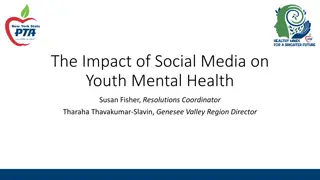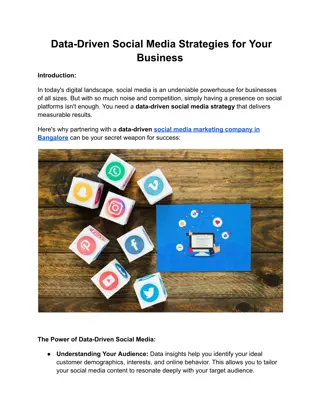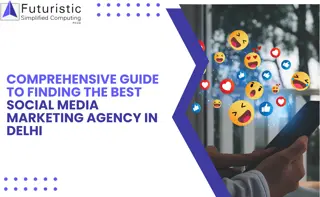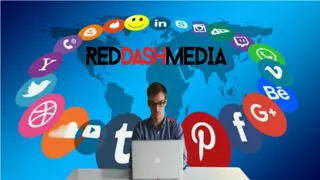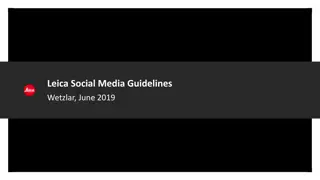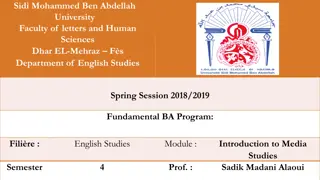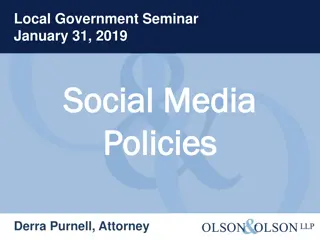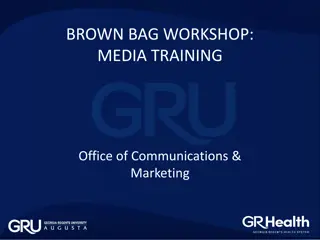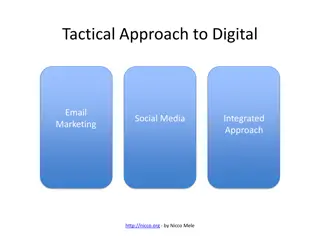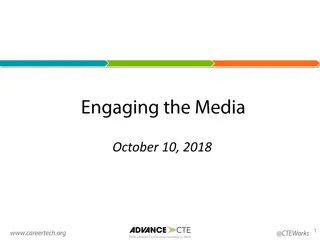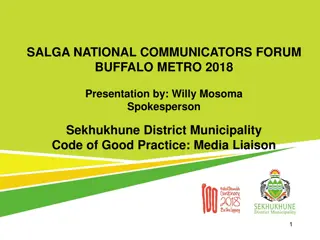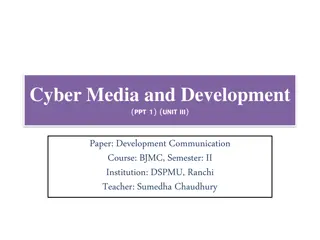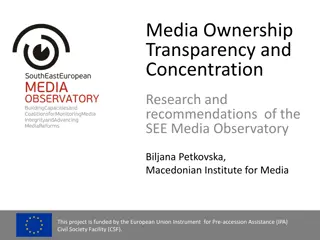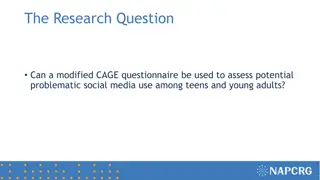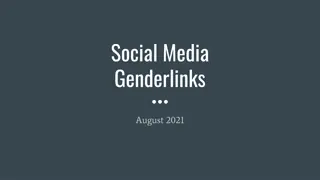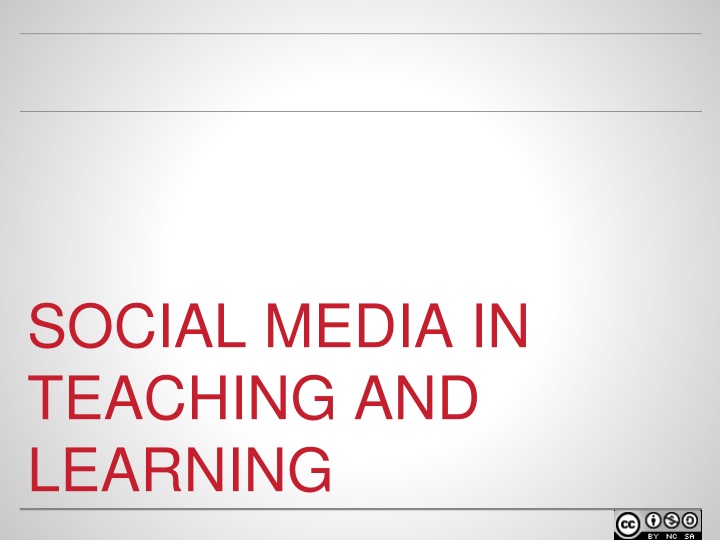
Enhancing Teaching and Learning Through Social Media
Explore the potential impact of social media on education, from current uses to ethical guidelines, effective strategies, and more. Discover how social media facilitates collaboration, networking, and professional skill development.
Download Presentation

Please find below an Image/Link to download the presentation.
The content on the website is provided AS IS for your information and personal use only. It may not be sold, licensed, or shared on other websites without obtaining consent from the author. If you encounter any issues during the download, it is possible that the publisher has removed the file from their server.
You are allowed to download the files provided on this website for personal or commercial use, subject to the condition that they are used lawfully. All files are the property of their respective owners.
The content on the website is provided AS IS for your information and personal use only. It may not be sold, licensed, or shared on other websites without obtaining consent from the author.
E N D
Presentation Transcript
SOCIAL MEDIA IN TEACHING AND LEARNING
WELCOME o Facilitator name Position at university Contact info
LEARNING OUTCOMES By the end of this module, you should be able to: identify the current uses of social media in teaching and learning; discuss the potential impact of using social media in a course; set out guidelines for the ethical use of social media in education; develop effective strategies for using social media; identify issues to consider when integrating social media into a course; design a learning activity that uses social media in a course.
AGENDA o What is Social Media? o Use of Social Media
WHAT IS SOCIAL MEDIA? o How would you define social media?
WHAT IS SOCIAL MEDIA? Social media are technologies that facilitate social interaction, make possible collaboration, and enable deliberation across stakeholders. These technologies include blogs, wikis, media (audio, photo, video, text) sharing tools, networking platforms (including Facebook), and virtual worlds. Bryer and Zavatarro (2011)
WHAT DOES SOCIAL MEDIA DO? Social media oallows students to self-select study groups and organize based on interests; oprovides easy access to resources from around the world, and oprovides access to learning beyond the classroom. Tony Bates - https://opentextbc.ca/teachinginadigitalage/chapter/9-5-5-social-media/
USING SOCIAL MEDIA TO DEVELOP PROFESSIONAL SKILLS According to Tony Bates, social media helps with the development of a variety of professional skills, such as: o Digital literacy o Independent and self-directed learning o Collaboration and teamwork o Development of global citizens o Inter-personal skills and networking o Knowledge management o Decision making
KEY SOCIAL MEDIA PLATFORMS Social Platforms can be divided into several key areas: o Media sharing o Bookmarking o Social publishing o Personal o Interest-based o Discussion forums
TYPES OF SOCIAL MEDIA Personal networks contain personal profiles that can be found in depth on Facebook and LinkedIn. Personal
TYPES OF SOCIAL MEDIA Interest- based Creating a group or page based around a common interest is an effective way to engage students in a conversation.
TYPES OF SOCIAL MEDIA Online communities are popular go-to sites for asking and answering questions, and for potentially engaging participants in debates over these questions. Discussion Forums
TYPES OF SOCIAL MEDIA Media Sharing Sites like Youtube and Instagram are primarily for sharing videos and images with the wider community.
TYPES OF SOCIAL MEDIA Bookmarking sites make it easier for students and educators to quickly access, save and re-locate frequently-used sites. Bookmarking
TYPES OF SOCIAL MEDIA Social Publishing Blogs and Wikis are excellent ways to get students writing and sharing their thoughts in a meaningful way.
THINK. PAIR. SHARE o How might you use some of the platforms discussed in your course? o How do you make use of them for your own purposes?
BENEFITS OF USING SOCIAL MEDIA o Increased level of communication (collaboration and participation), o Privacy: private space for free and open discussion, o Facilitates team projects implementation and review.
VIDEO o In this video, you ll watch interviews with instructors sharing the benefits of using social in their courses. oThink about your own pros and cons. Have the instructors alleviated any of your reservations?
CONSIDERATIONS FOR ADOPTION o Undetermined possibilities o Controversial opinions o Technical issues o Institutional factors For more information, please read Chapter 6 in the SMILE report: http://www.eun.org/c/document_library/get_file?uuid=23 2671ea-32ca-4272-8b24-20328aafe8bb&groupId=43887
VIDEO o In this video, Instructors share the challenges they faced when attempting to integrate social media activities into their curriculum. As you view the video, consider any challenges you are facing.
USE OF SOCIAL MEDIA How do you use social media? Discuss with a group of 3 or 4 some of the common ways you use social media. Do you use it mostly for personal, professional or teaching use?
FACULTY USE OF SOCIAL MEDIA The three main uses of social media for faculty are: o Personal o Professional (research related) o Teaching
GROWTH OF FACULTY USE http://www.onlinelearningsurvey.com/reports/social-media-for-teaching-and-learning-2013-report.pdf
VIDEO o We are going to hear how and why faculty and instructors use social media. Before watching the video, take a moment to think about your own use of social media for personal, professional or teaching purposes. What have your experiences been like?
BEST PRACTICES Using social media in the classroom is a relatively new phenomenon. The next few slides will discuss the following best practices for implementing social media into your courses. Quality Privacy Netiquette Expectations Presence Audience
BEST PRACTICES Clear expectations Participation level Which platform Assessment? Expectations
BEST PRACTICES Develop social presence Participate Know the tools Presence
BEST PRACTICES Audience larger than one Expose the class to a wider-audience Allow experts to contribute to discussion Audience
BEST PRACTICES Avoid prescribing a minimum number of contributions Emphasize connections and quality of discussions Focus on practice instead of mastery Quality
BEST PRACTICES Design activities that don t require personal accounts. Accept that for various reasons, some students will not be able to participate Privacy
BEST PRACTICES Use clear, concise, and appropriate language Respect others privacy Don t copy everyone in a message unless necessary Netiquette
VIDEO In this video, instructors share some of the best practices they ve learned through their own use of social media. While watching the video, think about the best practices we ve discussed and how the instructors are using these in their classes or research.
SUMMARY o Social media: is a form of user-generated electronic communication, has a wide-variety of uses and forms in the digital realm, has a number of benefits and challenges.
SUMMARY o Faculty usage is personal, professional and educational. o Instructors should: thoughtfully integrate social media into their course, follow effective practices, model appropriate use.
HOMEWORK o Choose a social media platform that you have not used before. o Create an account and add followers or contacts. o Explore the possibilities for interaction. o Design an activity for students in your courses
THANK YOU o Questions? o Comments? o Help? Contact information facilitator s and departmental
REFERENCES oAnderson, S. (2012, May 7). How to create social media guidelines for your school. Retrieved January 15, 2017, from Edutopia, https://www.edutopia.org/how-to-create-social-media-guidelines-school oDabbagh, N., & Kitsantas, A. (2012). Personal Learning Environments, social media, and self-regulated learning: A natural formula for connecting formal and informal learning. The Internet and Higher Education, 15(1), 3 8. Retrieved from http://anitacrawley.net/Articles/DabbaughPLE.pdf oDaer, A., & Potts, L. (2014). Teaching and learning with social media tools, cultures, and best practices. Programmatic Perspectives, 6(2), 21 40. Retrieved from https://www.academia.edu/8241386/Teaching_and_Learning_with_Social_Media_Tools_Cultures_and_Best_Practices oDefinition of SOCIAL MEDIA. Retrieved January 15, 2017, from Merriam-Webster Dictionary, https://www.merriam- webster.com/dictionary/social%20media oDron, J., & Anderson, T. (2014). Teaching Crowds. Retrieved from http://www.aupress.ca/books/120235/ebook/99Z_Dron_Anderson-Teaching_Crowds.pdf oGriesemer, J. A. (2012). Using Social Media to Enhance Students Learning Experience. Quality Approaches in Higher Education, 3(1), 8 11. Retrieved from http://rube.asq.org/edu/2014/03/best-practices/using-social-media-to-enhance- students-learning-experiences.pdf
REFERENCES oGupta, P. (2015, July 24). Importance of social media in higher education. Retrieved January 15, 2017, from Ed Tech Review, http://edtechreview.in/trends-insights/insights/2041-social-media-in-higher-education oHow to use social media as a learning tool. (2015, January 12). Retrieved January 15, 2017, from Edudemic, http://www.edudemic.com/how-to-use-social-media-as-a-learning-tool-in-the-classroom/ oMiller, J., Gilkerson, S., & Pignotti, L. (2015, May 21). Hey, @students! #Letschat: Using Social Media to Facilitate Research and Public Engagement. Retrieved January 15, 2017, from PraxisWiki, http://kairos.technorhetoric.net/praxis/tiki- index.php?page=PraxisWiki%3A_%3ASocial+Media+for+Digital+Engagement oSeaman, J., & Tinti-Kane, H. (2013, October ). Social Media for Teaching and Learning. Retrieved January 15, 2017, from Online Learning Survey, http://www.onlinelearningsurvey.com/reports/social-media-for-teaching-and-learning-2013-report.pdf oStoller, E. (2015, July 20). Why educators can t live without social media. Retrieved January 15, 2017, from JISC, https://www.jisc.ac.uk/news/why-educators-need-social-media-07-jul-2015 oRourke, L., Anderson, T., Garrison, D. R., & Archer, W. (2001). Assessing Social Presence In Asynchronous Text-based Computer Conferencing. Journal of Distance Education, 14(3), 51 70. Retrieved from http://auspace.athabascau.ca:8080/bitstream/2149/732/1/Assessing%20Social%20Presence%20In%20Asynchronous%20Te xt-based%20Computer%20Conferencing.pdf



